The Radeon R9 280X Review: Feat. Asus & XFX - Meet The Radeon 200 Series
by Ryan Smith on October 8, 2013 12:01 AM ESTOverclocking
With our look at the stock performance of our 280X cards complete, let’s take a brief look at overclocking.
When it comes to overclocking this is going to be a somewhat unfair competition for the two cards. The Asus card has by the very necessity of its existence already been binned. Furthermore while the Asus card supports voltage adjustments the XFX card does not (MSI Afterburner says it does, but adjusting the value has no effect). As such we get to drive what’s already a better GPU harder and with more voltage than the other. Still, this will give us the chance to see where everything will top out at.
| Radeon R9 280X Overclocking | ||||
| XFX Radeon R9 280X DD | Asus Radeon R9 280X DCU II TOP | |||
| Shipping Core Clock | 850MHz | 970MHz | ||
| Shipping Boost Clock | 1000MHz | 1070Mhz | ||
| Shipping Memory Clock | 6GHz | 6.4GHz | ||
| Shipping Boost Voltage | 1.2v | 1.2v | ||
| Overclock Core Clock | 880MHz | 1010MHz | ||
| Overclock Boost Clock | 1030MHz | 1110MHz | ||
| Overclock Memory Clock | 6.6GHz | 6.8GHz | ||
| Overclock Max Boost Voltage | 1.2v | 1.263v | ||
As it turns out, neither card overclocked by very much. The XFX card, lacking additional voltage, could only do 30MHz more, for a 4% base/3% boost overclock. Better luck was found on the memory with a 600MHz (10%) overclock there. The Asus card meanwhile was good for 40MHz more, for a 4% base/4% boost overclock, while its memory could do an additional 800MHz (13%). But at the same time this required dialing the voltage up to 1.263v – as high as we’re willing to go for this card. The power cost of doing that will be extreme.
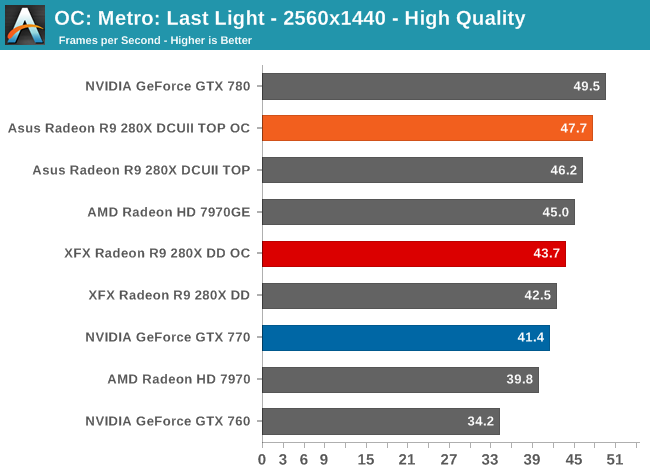
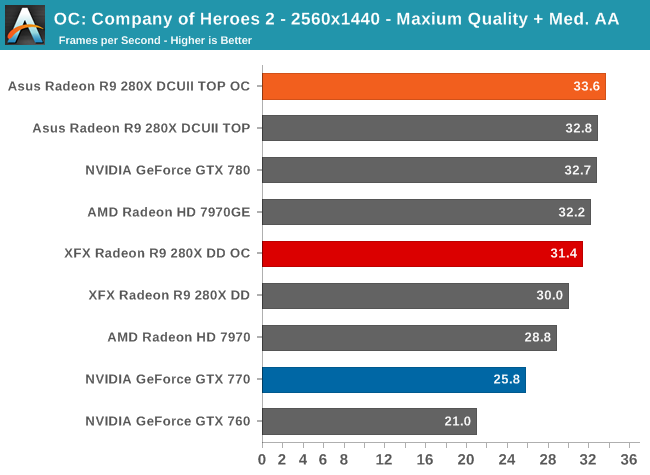
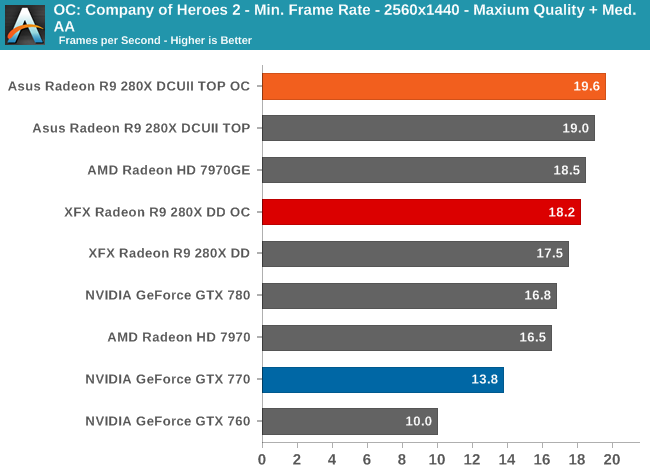
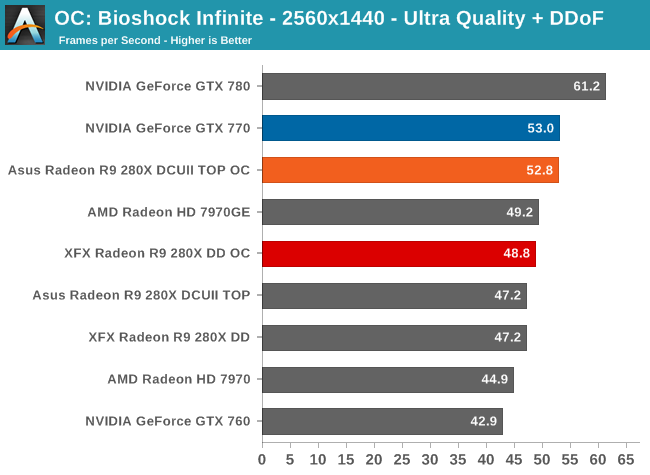
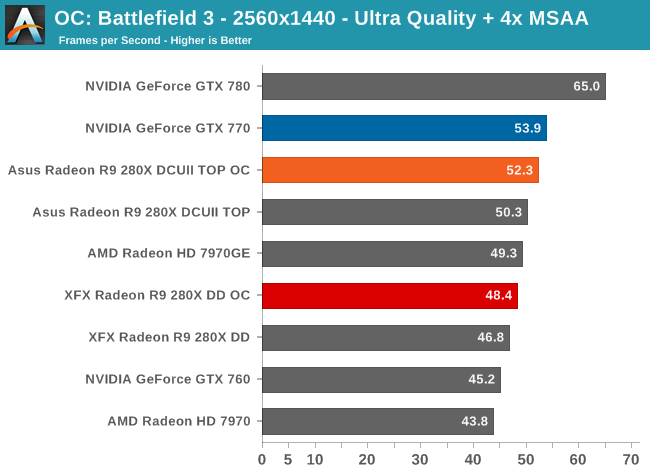
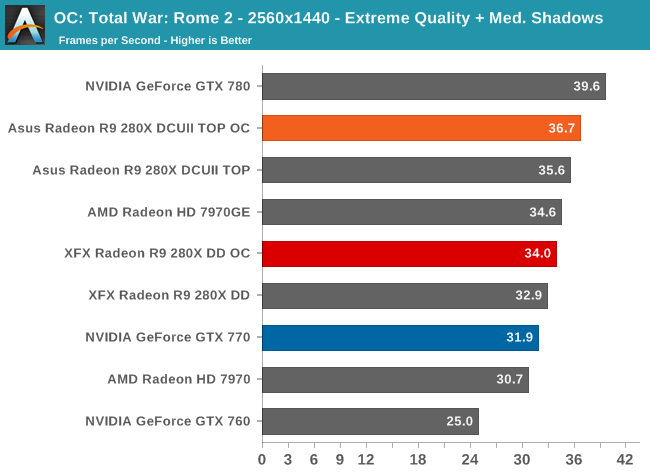
With our 280X cards primarily bottlenecked by GPU performance as opposed to memory performance, the performance gains from our overclocking adventure is limited. 3% on average for both cards is 3% for free, but it’s barely a useful overclock. We typically need 5% before overclocks start becoming interesting and significant enough to improve playability or make higher graphical settings practical.
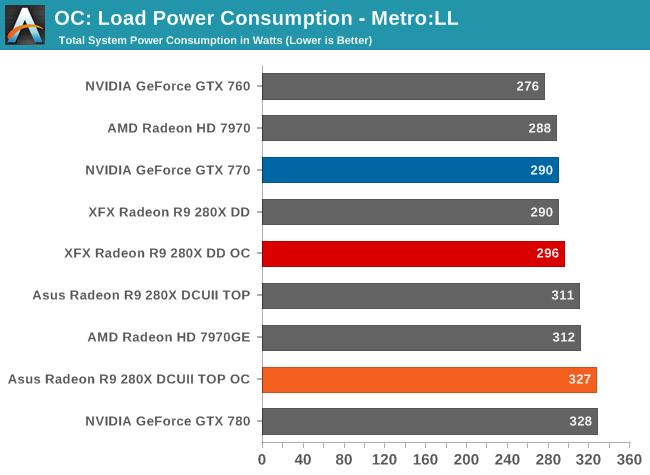
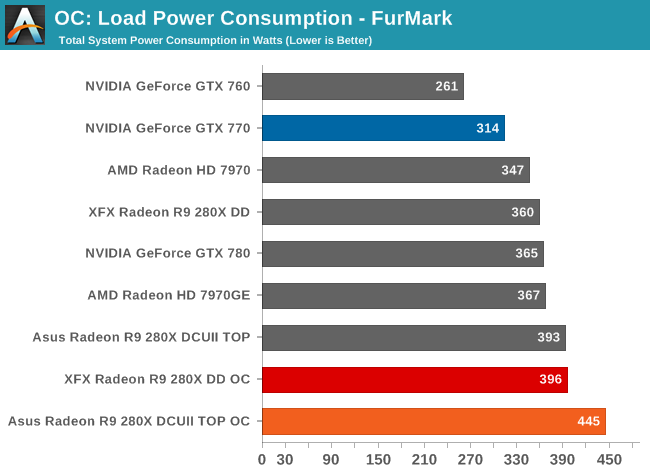
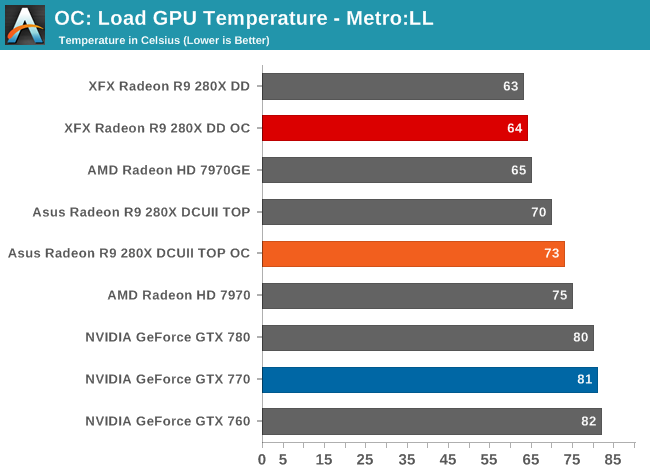
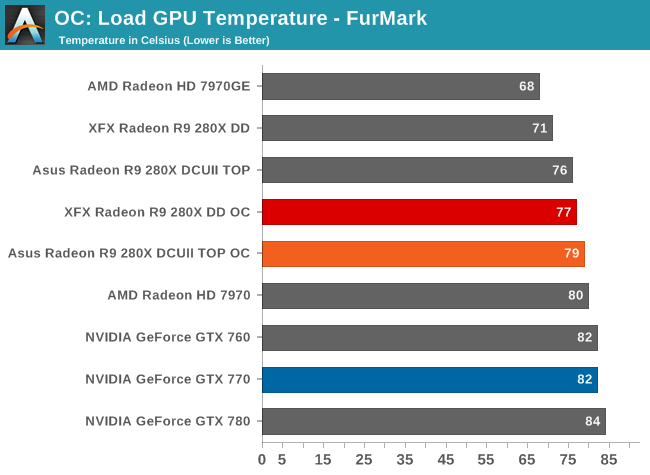
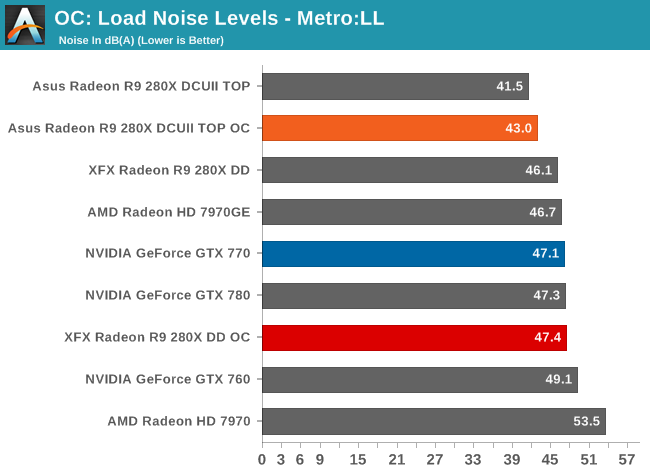
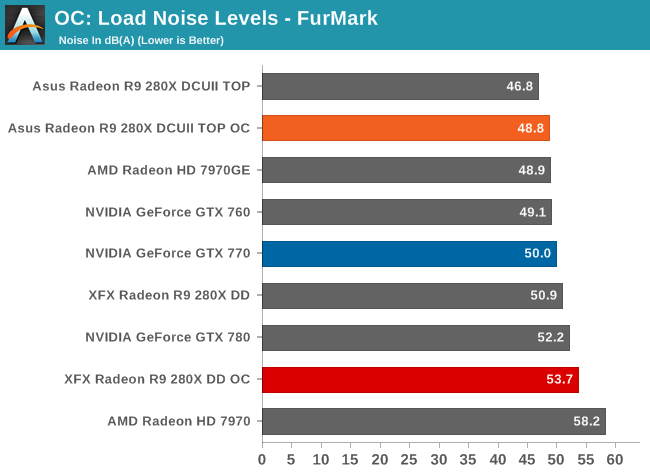
To the credit of the Asus card and its cooler, despite the increased clockspeeds, voltage, and power consumption, it’s able to keep GPU temperatures and load noise to reasonable levels given the circumstances. Still, with the increase in power required to achieve this overclock (particularly in the worst case scenario of FurMark) it’s hard to argue that the additional overclocking was worth the performance gains. With such an extensive factory overclock this is a card that may be better off left at factory clocks.
The XFX card meanwhile suffers much less of a power ramp up due to the lack of voltage control, but we’re still looking at something of a wash on the power/performance front.










151 Comments
View All Comments
AmdInside - Tuesday, October 8, 2013 - link
I still say its rebadge. The NVIDIA G92 went from 65nm to 55nm and lost analog TV out so by your definition G92 is not rebadged.Jumangi - Tuesday, October 8, 2013 - link
Yea that makes these totally different...ninjaquick - Tuesday, October 8, 2013 - link
What core difference exists between the 290X and the 280X? None really. The next gen's 370 is going to be a die-shrunk 280, and the 460 of the gen after that will be the same 7970 again. AMD is not going to bother releasing a new core design until the GCN is no longer apt for the task, which will only occur if HLSL/GLSL are retired completely.Gigaplex - Tuesday, October 8, 2013 - link
TrueAudio, some GPGPU instructions from GCN 1.1 plus whatever the 290X introduces on top of that is basically the core difference between 290X and 280X.Cellar Door - Tuesday, October 8, 2013 - link
I was looking forward to the R9 280X - simply because I hoped it would offer new features, revised silicon, maybe even new iteration of GCN. A REAL step forward - this is a let down. Because this hits my price point as I won't be able to afford their R9 290X, AMD was supposed to be a true champion of price - like always. It seems like I have no choice but to go with the green camp.silverblue - Tuesday, October 8, 2013 - link
Wait a minute... it trails the 770 on average by only a small amount and retails for $100 less. Sure, there's no game bundle, but how is this fleecing anybody?just4U - Tuesday, October 8, 2013 - link
One would think (since it's still pre-order status) that it's done in co-operation with their partners to help get rid of excess stock on the 7x line.. so Never settle bundles won't be offered until after all that is nearly gone. I suspect that such bundles will start being offered on the new line just as the holiday season starts.ltcommanderdata - Tuesday, October 8, 2013 - link
https://twitter.com/ID_AA_Carmack/status/386899206..."9x draw calls is credible over stock D3D, but Nvidia OpenGL extensions can give similar I mprocements."
In regards to Mantle, do you have any comment about John Carmack's report that AMD's claim of Mantle providing 9x more draw calls is already achievable by nVidia using their OpenGL extensions? Console porting is still an unique feature of Mantle, but on the draw call issue, if DirectX is slow to improve on this, then maybe AMD, Intel, and nVidia coming up with cross-vendor OpenGL extensions to address the issue may be a better solution than Mantle, especially given it converges with increased interest in OpenGL with SteamOS.
Pantsu - Tuesday, October 8, 2013 - link
AMD has made a similar statement. The new OpenGL extensions will bring similar improvements to what they advertise with Mantle, and that in the end the API will not be the bottleneck. As long as it's not Direct3D it seems. :D Perhaps even MS will eventually improve their game sooner or later.ananduser - Tuesday, October 8, 2013 - link
Have you not read Ryan's hunches on Mantle? Mantle is, or derived from, MS' low level Xbox API.